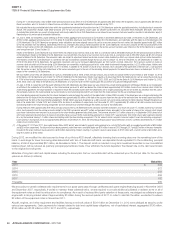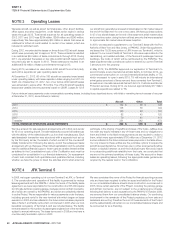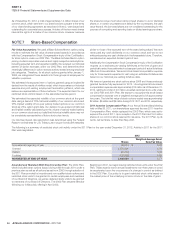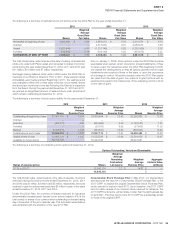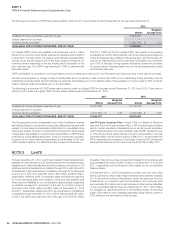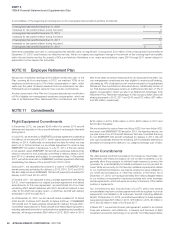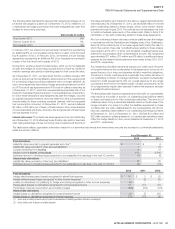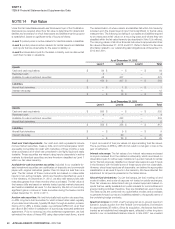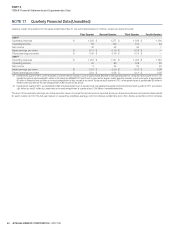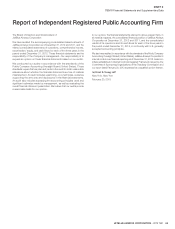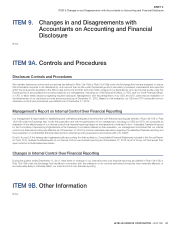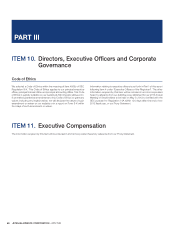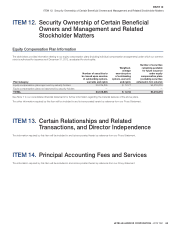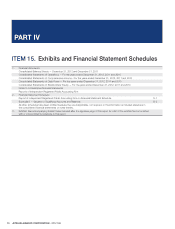JetBlue Airlines 2012 Annual Report Download - page 64
Download and view the complete annual report
Please find page 64 of the 2012 JetBlue Airlines annual report below. You can navigate through the pages in the report by either clicking on the pages listed below, or by using the keyword search tool below to find specific information within the annual report.
JETBLUE AIRWAYS CORPORATION-2012 10K60
PART II
ITEM 8Financial Statements and Supplementary Data
consolidated fi nancial position, results of operations, or cash fl ows.
However, it is not possible to predict with certainty the impact on us of
future environmental compliance requirements or the costs of resolving
the matter, in part because the scope of the remediation that may be
required is not certain and environmental laws and regulations are subject
to modifi cation and changes in interpretation.
Legal Matters
Occasionally, we are involved in various claims, lawsuits, regulatory
examinations, investigations and other legal matters arising, for the most
part, in the ordinary course of business. The outcome of litigation and other
legal matters is always uncertain. The Company believes that it has valid
defenses to the legal matters currently pending against it, is defending itself
vigorously and has recorded accruals determined in accordance with GAAP,
where appropriate. In making a determination regarding accruals, using
available information, we evaluate the likelihood of an unfavorable outcome
in legal or regulatory proceedings to which we are a party to and record a
loss contingency when it is probable that a liability has been incurred and
the amount of the loss can be reasonably estimated. These judgments are
subjective, based on the status of such legal or regulatory proceedings, the
merits of our defenses and consultation with legal counsel. Actual outcomes
of these legal and regulatory proceedings may materially differ from our
current estimates. It is possible that resolution of one or more of the legal
matters currently pending or threatened could result in losses material to
our consolidated results of operations, liquidity or fi nancial condition.
To date, none of these types of litigation matters, most of which are typically
covered by insurance, has had a material impact on our operations or
fi nancial condition. We have insured and continue to insure against most
of these types of claims. A judgment on any claim not covered by, or in
excess of, our insurance coverage could materially adversely affect our
fi nancial condition or results of operations.
DOT tarmac delay. In December 2009, the Department of Transportation,
or DOT, issued a series of passenger protection rules which, among other
things, impose tarmac delay limits for U.S. airline domestic fl ights. The
rules became effective in April 2010, and require U.S. airlines to allow
passengers to deplane within three hours on the tarmac, with certain
safety and security exceptions. Violators can face fi nes up to a maximum
of $27,500 per passenger. The new rules also introduce requirements
to disclose on-time performance and delay statistics for certain fl ights.
These new rules may have adverse consequences on our business and
our results of operations.
In October 2011, a severe winter storm and multiple failures of critical
navigational equipment in the New York City area severely impacted air
travel in the northeast. As a result, we and other domestic and international
carriers diverted fl ights to Hartford, CT’s Bradley International Airport, or
Bradley. We diverted a total of six fl ights to Bradley, fi ve of which were
held on the tarmac in excess of three hours. The DOT is investigating
these incidents and we may be subject to a monetary penalty under the
DOT’s tarmac delay regulations. Based on the allowable maximum DOT
fi ne proscribed by the regulation, we could be assessed a fi ne of up to
approximately $15 million. Since the tarmac delay rule went into effect
in April 2010, there have been multiple instances where carriers have
experienced extended tarmac delays in excess of three hours; however, the
DOT has only assessed one penalty against another carrier, for an amount
well below the maximum allowable fi ne of $27,500 per passenger. As a
result of the circumstances surrounding the airport, weather and air traffi c
conditions on that day, as well as the discretion granted to the DOT by the
regulation, we are unable to determine whether a fi ne will be assessed,
and if so, the amount of such fi ne. We have issued compensation to the
impacted customers in accordance with our Customer Bill of Rights,
and are fully complying with all requests made by the DOT in the course
of the investigation. We do not know when a fi nal determination by the
DOT will be made.
Employment Agreement Dispute. In or around March 2010, attorneys
representing a group of current and formerpilots, or the Claimants’,
fi led a Request for Mediation with the American Arbitration Association
concerning a dispute over the interpretation of a provision of their individual
JetBlue Airways Corporation Employment Agreements for Pilots, or
Employment Agreements. In their Fourth Amended Arbitration Demand,
dated June 8, 2012, Claimants (approximately 944 current pilots and 26
former pilots) alleged that JetBlue breached the Base Salary provision of
the Employment Agreements and sought back pay and related damages,
for each of 2002, 2007 and 2009. In July 2012, in response to JetBlue’s
partial Motion to Dismiss, the Claimants withdrew the 2002 claims.The
Claimants have not specifi ed an exact amount of damages sought. As
such, we are unable to determine a range of potential loss at this time.
However, pilot salaries currently represent approximately 40% of our total
consolidated salaries; therefore, any judgment in the Claimants’ favor for
any or all of the years in question could have a material adverse impact
on our results of operations, liquidity and/or fi nancial condition.
Discovery was completed and expert reports were fi led during the fourth
quarter of 2012. An arbitration hearing is scheduled in March 2013. In
this arbitration, the Company intends to continue to vigorously defend
its interpretation of the Employment Agreements at issue. While the
outcome of any arbitration is uncertain, the Company believes the claims
are without merit.
NOTE 13 Financial Derivative Instruments and Risk Management
As part of our risk management techniques, we periodically purchase
crude or heating oil option contracts to manage our exposure to the
effect of changes in the price and availability of aircraft fuel. Prices for
these commodities are normally highly correlated to aircraft fuel, making
derivatives of them effective at providing short-term protection against
sharp increases in average fuel prices. We also periodically enter into jet
fuel swaps, as well as basis swaps for the differential between heating oil
and jet fuel, to further limit the variability in fuel prices at various locations.
To manage the variability of the cash fl ows associated with our variable
rate debt, we have also entered into interest rate swaps.
We do not hold or issue any derivative fi nancial instruments for trading
purposes.
Aircraft fuel derivatives: We attempt to obtain cash fl ow hedge accounting
treatment for each aircraft fuel derivative we enter into. This treatment is
provided for under the Derivatives and Hedging topic of the Codifi cation,
which allows for gains and losses on the effective portion of qualifying
hedges to be deferred until the underlying planned jet fuel consumption
occurs, rather than recognizing the gains and losses on these instruments
into earnings during each period they are outstanding. The effective portion
of realized aircraft fuel hedging derivative gains and losses is recognized
in fuel expense in the period the underlying fuel is consumed.
Ineffectiveness results, in certain circumstances, when the change in the
total fair value of the derivative instrument differs from the change in the
value of our expected future cash outlays for the purchase of aircraft fuel
and is recognized immediately in interest income and other. Likewise, if a
hedge does not qualify for hedge accounting, the periodic changes in its
fair value are recognized in the period of the change in interest income and
other. When aircraft fuel is consumed and the related derivative contract
settles, any gain or loss previously recorded in other comprehensive income
is recognized in aircraft fuel expense. All cash fl ows related to our fuel
hedging derivatives are classifi ed as operating cash fl ows.
Our current approach to fuel hedging is to enter into hedges on a discretionary
basis without a specifi c target of hedge percentage needs. We view our
hedge portfolio as a form of insurance to help mitigate the impact of price
volatility and protect us against severe spikes in oil prices, when possible.


